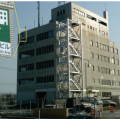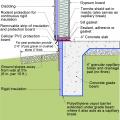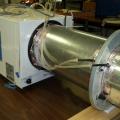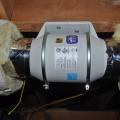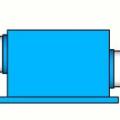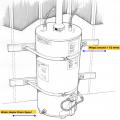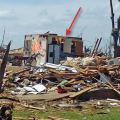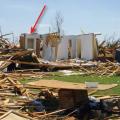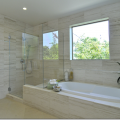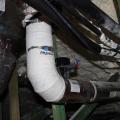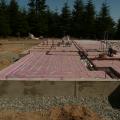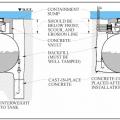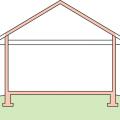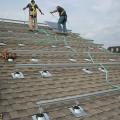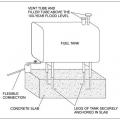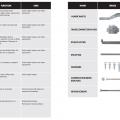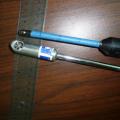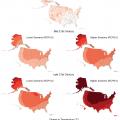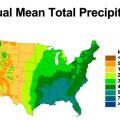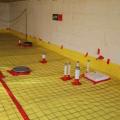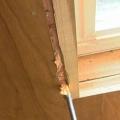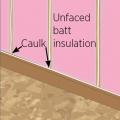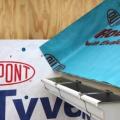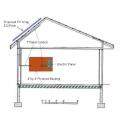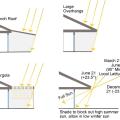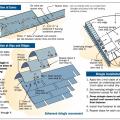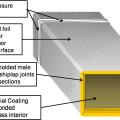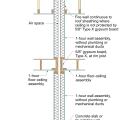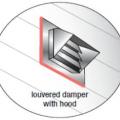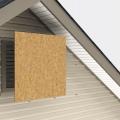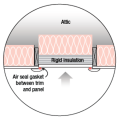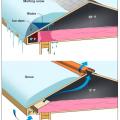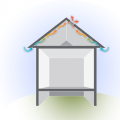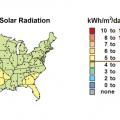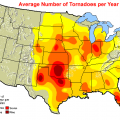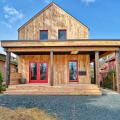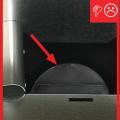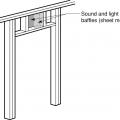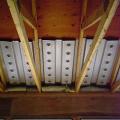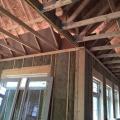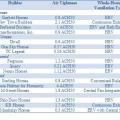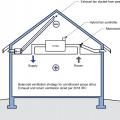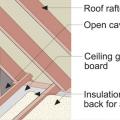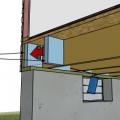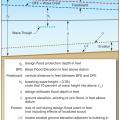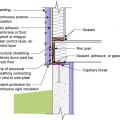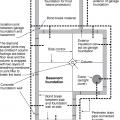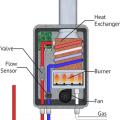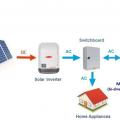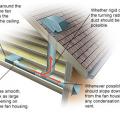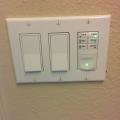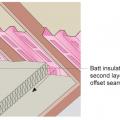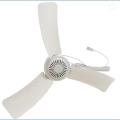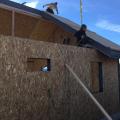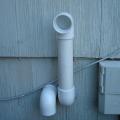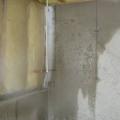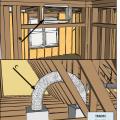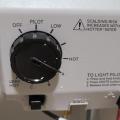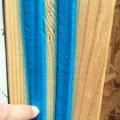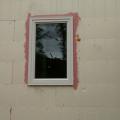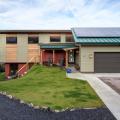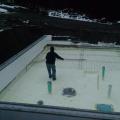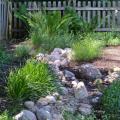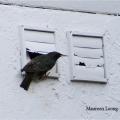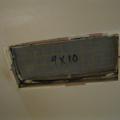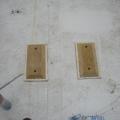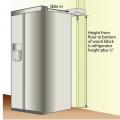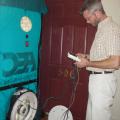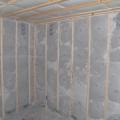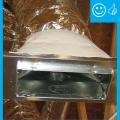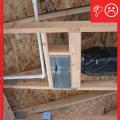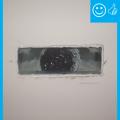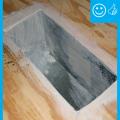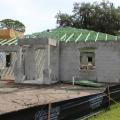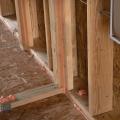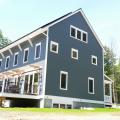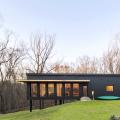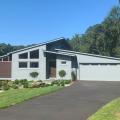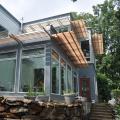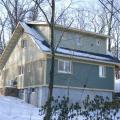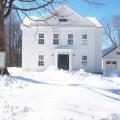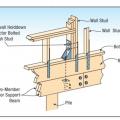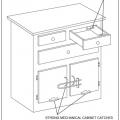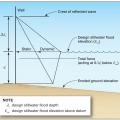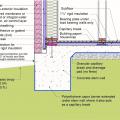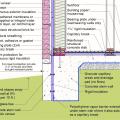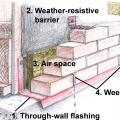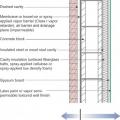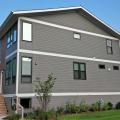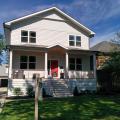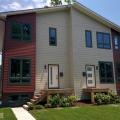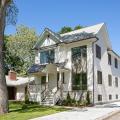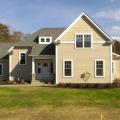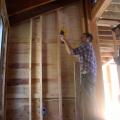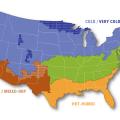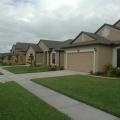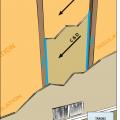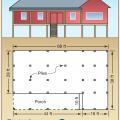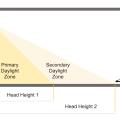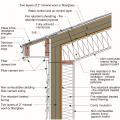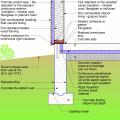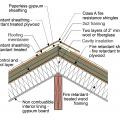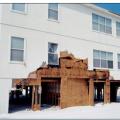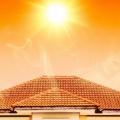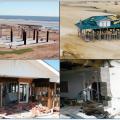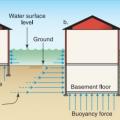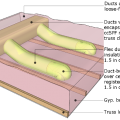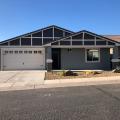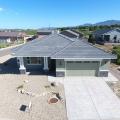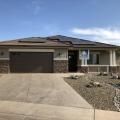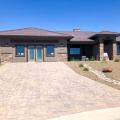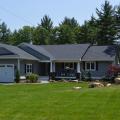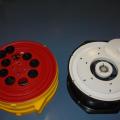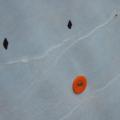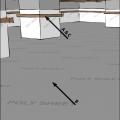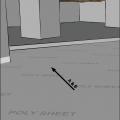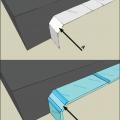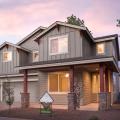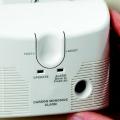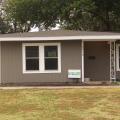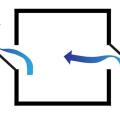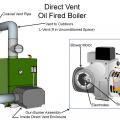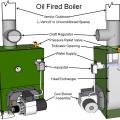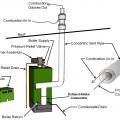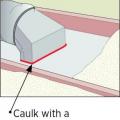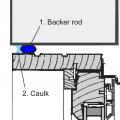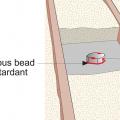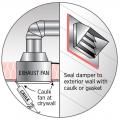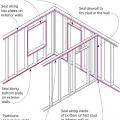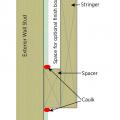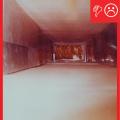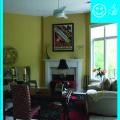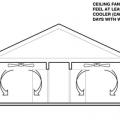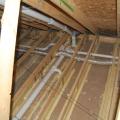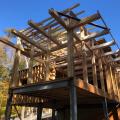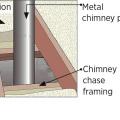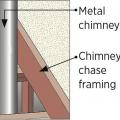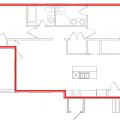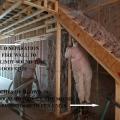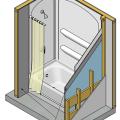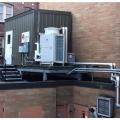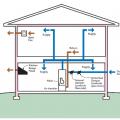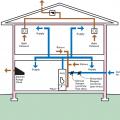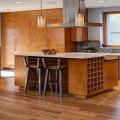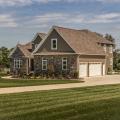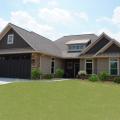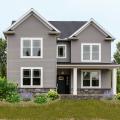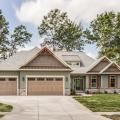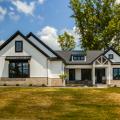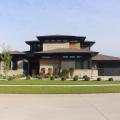Showing results 501 - 750 of 4973
An extensive battery storage system saves solar-generated power in this 4-unit multifamily building for use during evening peak hours.
An exterior metal staircase was added to this concrete building for roof access and refuge during tsunamis in Kesennuma, Japan
An exterior wall braced using the let-in-bracing (LIB) method with no exterior sheathing
An externally insulated slab-on-grade is pest-protected by a metal termite shield under sill plate, metal-flashing-wrapped foam under siding, a removable inspection strip of PVC-covered foam, and 2 feet of gravel next to the foundation.
An in-line airflow station installed in rigid duct provides a location to measure ventilation airflow
An in-line exhaust fan supplements the ability to exhaust moisture-laden air and lint from a dryer
An independent ducted dehumidifier draws air from and supplies air to the living space using its own ducts, not ducts that are connected to the HVAC system
An indoor water heater should be secured to the wall’s studs to prevent it from moving or tipping over in the event of an earthquake
An infrared camera can show heat transfer and air leaks not visible to the naked eye.
An innovative U-shaped heat pump offers SEER 15 efficiency and operation with smart phones
An Inset Shear Panel constructed with 2x4 dimensional lumber installed into a 2x6 stud bay
An installer fills these wall cavities with spray foam insulation, which will be trimmed flush with the stud faces after it dries and hardens.
An insulated spline is another option for avoiding thermal bridging at SIP panel seams
An interior bathroom left partially intact after an EF4 tornado in Tuscaloosa, AL, 2011
An interior closet left partially intact after an EF4 tornado in Tuscaloosa, AL, 2011
An interior shade that closes from the bottom up can work in conjunction with an exterior overhang to block lower-angle sunlight while still allowing view through the upper portion of the window that is shaded by the overhang.
An IR camera image shows gaps around HVAC flue pipes allow conditioned air to leak through blown fiberglass into the attic
An NFRC glazing system energy performance label will report U-factor, solar heat gain coefficient, visible transmittance, and air leakage; if the window is ENERGY certified, the ENERGY STAR label will be located next to the NFRC label
An on-demand hot water pump speeds water delivery to the low-flow plumbing fixtures for significant water and energy savings.
An outdoor shower off the master bathroom keeps heat and humidity outside for this hot-humid climate home.
An outside air duct brings in fresh air that is filtered and distributed to the home through the heat pump’s air handler and ducts. The system is electronically controlled in conjunction with the home’s exhaust fans for balanced ventilation.
An ultra-efficient layer of R-20 rigid foam foundation insulation covers the ground underneath the vapor barrier and radiant floor loops, which will circulate water heated by an ultra-efficient geo heat pump.
An underground fuel tank is anchored onto poured-in-place concrete counterweights.
An uninsulated (or existing insulated) basement slab is retrofitted to reduce moisture transmission by sealing with epoxy paint.
An unvented cathedralized attic has the air, thermal, and vapor control layers at the roof line
Anchor bolts should be at least 1/2-inch diameter and should be embedded at least 7 inches into the foundation, spaced not more than 6 feet apart, and between 3.5 and 12 inches from each end of the sill plates.
Anchorage failure in sliding glass doors due to negative pressures from hurricane force winds.
Anchoring a fuel tank to a concrete slab is recommended to avoid displacement if flooding occurs.
Anchoring hardware is used to tie down equipment and components of the home to resist high winds and hurricanes.
Anemometers, including the vane style (lower) and hotwire style (upper) are used to measure air velocity to calculate airflow
Angle support framing is added to brace a long gable overhang constructed using the ladder framing method.
Annual average temperatures have increased across North America when comparing the present day to the first half of the last century, and are projected to increase for mid-century and end-of-century relative to the near-present
Annual Wildfires and Acres Burned, including Wildland Fires on Federal and Nonfederal lands (1991-2020)
Anode bars can protect boiler steel without the bad effects of chemical water treatment
Any holes through the vapor barrier installed over the basement floor slab are thoroughly sealed as part of the foundation water barrier system.
Apply self-adhesive flashing over top edge of the wall flashing, diverter, and housewrap
AquaZephyr, LLC built this multifamily home in the cold climate in Ithaca, NY, and certified it to DOE Zero Energy Ready Home specifications in 2016.
Architectural awnings offer year-round weather protection and keep overhead summer sun off windows while allowing lower winter sun to provide beneficial warmth.
Architectural shading can include large eaves, a porch roof, a well-designed pergola, or other building elements
Assembly can be used in IECC CZ 3 and above to thermally isolate garages in multifamily row houses with slab foundations. For unheated garages, it is unnecessary to insulate wall between garage and exterior of slab or slab underneath garage.
Assembly details for a 1-hour separation wall between dwelling units in multifamily row houses
Assembly details for a 2-hour separation wall between dwelling units in multifamily row
Assembly details for a double-1-hour separation wall between dwelling units in multifamily row houses
At the outlet of the dryer exhaust duct, install a hooded vent with a louvered damper
Attach a strong permanent cover to gable end vents before a severe storm strikes to prevent moisture intrusion.
Attach the interior 2x4 wall to the exterior wall top plate with a flat metal connector plate
Attic ventilation can reduce the likelihood of ice dam formation by cooling the roof deck.
Attic ventilation fans exhaust hot air from the attic while replacing it with cooler air from the outside through intake vents
Attractive landscaping can help high-performance home builders sell their homes faster.
Awnings and overhangs should have strong and continuous connections to resist wind forces that might pull them off the structure.
Awnings, overhangs, and porches shield windows and doors from sun, rain, and snow in this sunny mountain locale.
Back-draft damper still has a piece of tape that prevented it from rattling during shipping
Backflow prevention devices keep water and sewage from entering the home during a flood preventing damage and health and safety issues.
Backup generators usually run on gas, propane, or diesel-powered and typical sizes for homes generate 2,500 to 7,500 watts.
Baffles allow ventilation under roof decking while keeping wind from blowing insulation back from the edges of an attic.
Baffles are installed to protect airflow from the soffits to the ridge vents before the ceiling drywall and attic insulation are installed.
Baffles made from sheet metal are installed to minimize sound and light transmission
Baffles provide an air space over the insulation to guide ventilation air from the soffit vents up along the underside of the roof deck
Baffles will keep insulation out of the soffit vents and wind out of the insulation in this vented attic.
Balanced ventilation dominates ventilation specifications by Zero Energy Ready Home builders
Balloon-framed walls have no top plate to prevent air flow into wall cavity
Basement plan showing sump pump location and perimeter drain that empties to the sump pit
Basic components of a gas tankless water heater include a high-powered burner, fan, and heat exchanger; condensing gas water heaters also have a secondary heat exchanger and a piped air intake to the sealed combustion chamber
Basic foundation types: deep basement, submerged crawl space, flush crawl space, and slab-on-grade
Basic layout diagram of an AC-coupled solar battery system with a Grid-tied (hybrid) setup
Bathroom exhaust fans are timer-operated to encourage removal of moisture from the home.
Batt insulation is installed in two layers in perpendicular directions against the baffle to full required insulation height
Batt insulation is installed in two layers with offset seams against the baffle to full code-required insulation height
Batt insulation should be cut to fit around wiring so that insulation can completely fill the wall cavity
Because all of the structural load is carried by the SIP roof and wall panels, no trusses are needed, allowing the home to have vaulted ceilings and open interiors throughout.
Because flue temperatures are cool, intake and exhaust ducts on a Category 4 direct-vent sealed-combustion condensing furnace can be made of PVC
Because heat pump clothes dryers recycle the hot air in the drum rather than venting it, they use 70% less energy than conventional electric clothes dryers while drying clothes in the same amount of time
Because the above-grade potions of the wall lack exterior insulation, condensation and even ice form during cold winter conditions
Because this ICF and spray foamed house is so well insulated, the HVAC system is smaller, the round metal ducts are smaller diameter, and the duct layout is more compact.
Bedrooms pressure-balanced and provide 1 sq. in. of free area opening per 1 CFM of supply air or achieve a Rater-measured pressure differential ≤ 3 Pa
Bedrooms pressure-balanced and provide 1 sq. in. of free area opening per 1 CFM of supply air or achieve a Rater-measured pressure differential ≤ 3 Pa
Bees made a nest in the drainage plane behind a brick veneer wall by entering via unscreened weep holes
Before conducting a blower door test, turn off any ambient gas water heater located in the conditioned space of the home; when the test is finished, turn the water heater back on and reset the pilot light if needed.
Before installing drywall, contractors install two beads of a sprayer-applied elastomeric sealant along framing and top plates to forma a flexible, air-tight seal between the framing and dry wall.
Before installing the windows, the window rough openings are sealed with a liquid-applied flashing that provides a seamless moisture and air barrier to protect the wall from water intrusion.
Before sealing and insulating the crawlspace, the windows were sealed, the window wells backfilled, and sumps pumps were installed that discharged to the gutter downspouts
Bellingham Bay Builders built this custom for buyer home in the cold climate in Friday Harbor, WA, and certified it to DOE Zero Energy Ready Home specifications in 2020.
Bellingham Bay Builders built this custom for buyer home in the marine climate in Bellingham, WA, and certified it to DOE Zero Energy Ready Home specifications in 2018.
Bellingham Bay Builders built this custom for buyer home in the marine climate in Seattle, WA, and certified it to DOE Zero Energy Ready Home specifications in 2019.
Berms are compacted earth or gravel ridges that slow the flow of water from rain, riverine flooding, or storm surges in coastal areas.
Berms, swales, bioswales, ridges, and vegetation all help to control rainwater runoff on residential sites.
Between the ICF foundation walls, the builder sprayed closed-cell spray foam directly onto the gravel base to provide a vapor barrier and continuous layer of insulation under the slab.
Bioswales or rain gardens filter storm water through vegetation and rock and sand substrate layers.
Bioswales receive rainfall and filter it through different substrate layers, preventing flooding and storm surges from occurring
Blocking installed on a flat roof for a PV system rack is sealed around the edges with sealant then will be covered with self-adhering roof membrane to prevent water leakage
Blower door tests can be an important part of a home energy assessment to check for comfort improvements
Blown cellulose insulation completely fills the netted wall and ceiling cavities.
Bolted metal hurricane strapping ties the roofing to the framing and the framing to the foundation walls for resistance to high winds.
Borate-treated roof trusses and concrete masonry unit (CMU) walls are among the pest-resistant features of these Florida homes.
Bottom plate-subfloor joints, corners, and wiring holes are all sealed with foam to improve the airtightness of the homes.
BPC Green Builders built this custom for buyer home in the cold climate in Clinton, CN, and certified it to DOE Zero Energy Ready Home specifications in 2017.
BPC Green Builders built this custom for buyer home in the cold climate in Stamford, CT, and certified it to DOE Zero Energy Ready Home specifications in 2021.
BPC Green Builders built this custom for buyer home in the cold climate in Trumbull, CT, and certified it to DOE Zero Energy Ready Home specifications in 2020.
BPC Green Builders built this custom home in the cold climate in New Fairfield, CT, and certified it to DOE Zero Energy Ready Home specifications in 2013.
BPC Green Builders built this custom home in the cold climate in New Fairfield, CT, and certified it to DOE Zero Energy Ready Home specifications in 2014.
BPC Green Builders built this custom home in the cold climate in Watertown, CN, and certified it to DOE Zero Energy Ready Home specifications in 2015.
Braced cripple wall construction in crawlspace anchored to framing and foundation
Brick veneer framed wall supported by a concrete slab-on-grade foundation with a turn-down footing insulated on its top surface, showing anchorage of the wall to the foundation for seismic resistance
Brick veneer is supported by a concrete stem wall thermally separated from the slab-on-grade foundation with turn-down footing which is also insulated on top; anchorage for seismic resistance is also shown
Brick wall assembly for a hot-humid climate with no Class I vapor retarder and with an air gap (drained cavity) to dissipate vapor driven into the wall by the sun.
BrightLeaf Homes built this custom for multi-family home in the cold climate in Forest Park, IL, and certified it to DOE Zero Energy Ready Home specifications in 2020.
BrightLeaf Homes built this custom spec home in the cold climate in Brookfield, IL, and certified it to DOE Zero Energy Ready Home specifications in 2016.
BrightLeaf Homes built this custom spec home in the cold climate in Brookfield, IL, and certified it to DOE Zero Energy Ready Home specifications in 2017.
BrightLeaf Homes built this custom spec home in the cold climate in La Grange, IL, and certified it to DOE Zero Energy Ready Home specifications in 2018.
BrightLeaf Homes built this production home in the cold climate in La Grange, IL, and certified it to DOE Zero Energy Ready Home specifications in 2018.
Brookside Development built this production home in the cold climate in Woodbridge, CT, and certified it to DOE Zero Energy Ready Home specifications in 2014.
Brookside Development built this production home in the cold climate in Woodbridge, CT, and certified it to DOE Zero Energy Ready Home specifications in 2014.
Builders in hot climates may uses a radiant barrier product that comes adhered to the underside of the roof sheathing to reduce solar heat gain into the home.
Builders like David Weekley Homes (pictured here) participated in DOE's Zero Energy Ready Home program, have consistently ranked highest in overall customer satisfaction and quality in surveys of new home buyers.
Builders use an infrared camera to “see” heat flow and air leakage around a window during construction.
Building America worked with Mercedes Homes in east Florida to design homes using cast-in-place concrete walls capable of withstanding wind-blown debris impacts of up to 200 mph (Source: Mercedes Homes).
Building cavities not used as supply or return ducts unless they meet Items 3.2, 3.3, 4.1, and 4.2 of this Checklist
Building elevation and plan view of roof showing longitudinal shear walls; dimensions are wall-to-wall and do not include the 2-ft roof overhang.
Building energy codes often reference primary and secondary daylight when specifying daylighting control requirements – the primary daylight zone or distance into the room from the window equals the window height from the floor.
Building perimeter detail view of the recommended approach for groundwater management in cases where the foundation is entirely above the groundwater table.
Building Science Corporation used convection to help cool this structural insulated panel (SIP) cottage in Georgia.
Building section connecting an unvented roof assembly constructed with fire-resistant and fire-retardant materials to a wall assembly with similar materials.
Building section connecting wall assembly constructed with fire-resistant and fire-retardant materials to a foundation assembly with similar materials.
Building section showing a vapor diffusion ridge port constructed with fire-resistant and fire-retardant materials.
Building siding extended down and over the breakaway wall so the upper wall was damaged when the lower wall broke away.
Buildings damaged by a hurricane storm surge: upper homes on gulf shoreline were hit by large waves above the lowest floor, lower left home on bay and right school 1.3 miles from gulf shoreline were hit by surge and small waves.
Built-up beam connections, knee brace connections, and diagonal brace connections for wood piles.
Buoyancy force on dry floodproofed homes with deep basements leads to possible foundation damage
Buried ducts are laid on the floor of a vented attic then covered with spray foam and blown attic floor insulation
By plotting the heating capacities at -4°F and 5°F and drawing a line between them, the capacity at 0°F can be estimated
C & B Custom Homes built this custom for custom spec home in the mixed-dry climate in Clarkdale, AZ, and certified it to DOE Zero Energy Ready Home specifications in 2020.
C & B Custom Homes built this custom spec home in the mixed-dry climate in Clarkdale, AZ, and certified it to DOE Zero Energy Ready Home specifications in 2019.
C & B Custom Homes built this custom spec home in the mixed-dry climate in Clarkdale, AZ, and certified it to DOE Zero energy Ready Home specifications in 2018.
C & B Custom Homes built this custom spec home in the mixed-dry climate in Clarkdale, AZ, and certified it to DOE Zero Energy Ready Home specifications in 2021.
Cabinets can be connected and secured to the wall, grounding them and keeping them more secure in the case of a seismic event
Calculate projection factor (PF) by dividing overhang (A) by length of window (B).
Caldwell and Johnson built this custom home in the cold climate in Exeter, RI, and certified it to DOE Zero Energy Ready Home specifications in 2013.
Calibrated blower door fans are used for envelope leakage testing
Calibrations are specific to each airflow station model and size and are needed to convert measured station pressure to airflow
Canned spray foam is an excellent sealant for sealing cracks, seams, and holes around pipes up to a half inch in diameter.
Capillary break at all crawlspace floors using > 6 mil polyethylene sheeting, lapped 6-12 in., and secured in the ground at the perimeter using stakes
Capillary break at all crawlspace floors using ≥ 6 mil polyethylene sheeting, lapped 6-12 in., and lapped up each wall or pier and fastened with furring strips or equivalent
Capillary break at all crawlspace floors using ≥ 6 mil polyethylene sheeting, lapped 6-12 in., and placed beneath a concrete slab
Capillary break beneath all slabs (e.g., slab on grade, basement slab) except crawlspace slabs using either: ≥ 6 mil polyethylene sheeting lapped 6-12 in., or ≥ 1 in. extruded polystyrene insulation with taped joints
Capstone Homes built this affordable home in the cold climate in Greenville, SC, and certified it to DOE Zero Energy Ready Home specifications in 2017.
Careful landscaping can preserve roof-top solar exposure and provide shading to help control solar gain through windows.
Carl Franklin Homes built this affordable home in the hot-humid climate in Garland, TX, and certified it to DOE Zero Energy Ready Home specifications in 2016.
Carl Franklin Homes built this custom home in the cold climate in Garland, TX, and certified it to DOE Zero Energy Ready Home specifications in 2015.
Casement windows or wing walls can create zones of higher pressure (right) and lower pressure (left) to encourage cross ventilation when wind is flowing parallel to window openings
Category III oil-fired, sealed-combustion boiler configured as a direct-vented appliance that draws its combustion air from outside
Category III oil-fired, sealed-combustion boiler with the burner assembly cover removed
Caulk air seals the boot to the ceiling
Caulk holes in the electrical box, caulk the wire holes, and caulk the face of the box to the drywall
Caulk may be used to seal the cracks in the band joist area
Caulk or foam seal between the exhaust fan housing and the ceiling gypsum; install a gasket or caulk around the exterior exhaust duct vent
Cavity used for return is not insulated and is not air sealed, which will pull in air from outside
Ceiling fan meets minimum clearance
Ceiling fans can be used to aid a night flush strategy by helping to cool down wall and floor surfaces more thoroughly at night, and by providing comfort ventilation during the day
Ceiling joists extend out to provide very strong roof overhangs that will resist uplift pressures in high winds.
Ceiling, wall, floor, and slab insulation levels shall meet or exceed Builders Challenge levels
Cement board (shown in dark grey) is installed behind an installed tub and shower surround.
Central heat pump water heaters like this fully packaged system provide efficient, reliable domestic hot water for multifamily buildings; storage tanks are within the enclosure, and the heat pump is seen just outside.
Central-fan-integrated supply ventilation with exhaust fans for intermittently balanced whole-house ventilation
Certified low-emission composite wood products
Charis Homes built this custom for buyer home in the cold climate in North Canton, OH, and certified it to DOE Zero Energy Ready Home specifications in 2016.
Charis homes built this custom for buyer home in the cold climate in North Canton, OH, and certified it to DOE Zero Energy Ready Home specifications in 2019.
Charis Homes built this custom for custom for buyer home in the cold climate in Aurora, OH, and certified it to DOE Zero Energy Ready Home specifications in 2020.
Charis Homes built this custom spec home in the cold climate in North Canton, OH, and certified it to DOE Zero Energy Ready Home specifications in 2017.
Charis Homes built this custom spec home in the cold climate in Uniontown, OH, and certified it to DOE Zero Energy Ready Home specifications in 2021.
Charles Thomas built this custom for buyer home in the cold climate in Valley, NE, and certified it to DOE Zero Energy Ready Home specifications in 2017.
Charles Thomas Homes built this custom home in the cold climate in Omaha, NE, and certified it to DOE Zero Energy Ready Home specifications in 2015.

